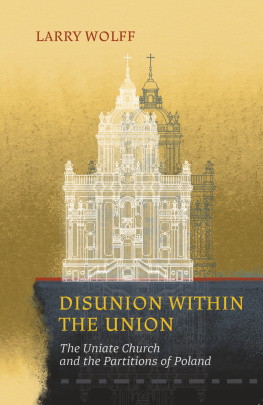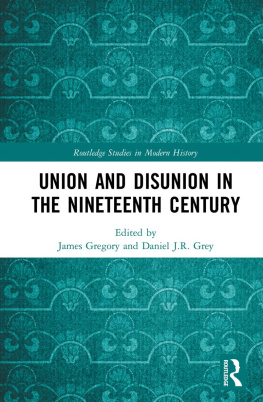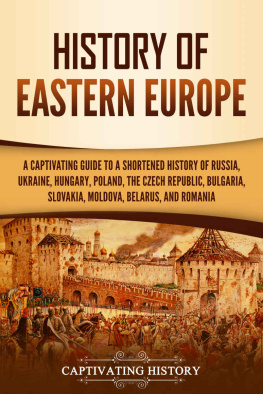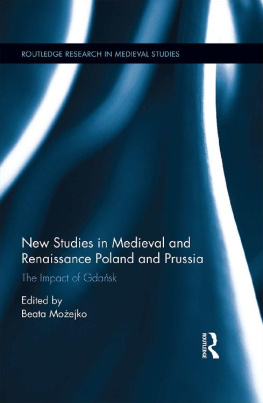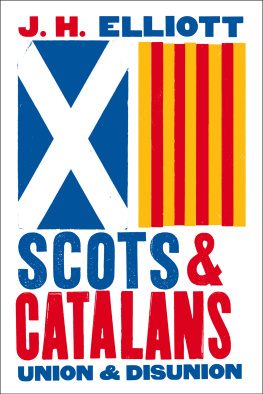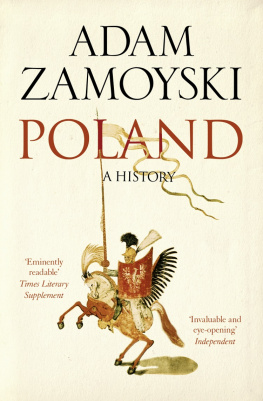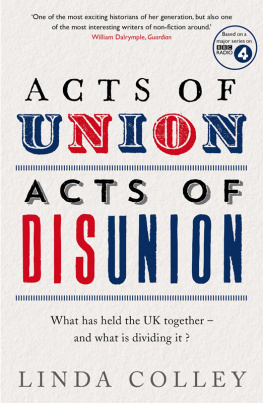Disunion within the Union
Ukrainian Research Institute Harvard University
Harvard Papers in Ukrainian StudiesHURI Editorial Board
Michael S. Flier
George G. Grabowicz
Serhii Plokhy, Chairman
Oleh Kotsyuba, Manager of Publications
Cambridge, Massachusetts
Disunion within the Union
The Uniate Church and the Partitions of Poland
Distributed by Harvard University Press for the Ukrainian Research Institute Harvard University
The Harvard Ukrainian Research Institute was established in 1973 as an integral part of Harvard University. It supports research associates and visiting scholars who are engaged in projects concerned with all aspects of Ukrainian studies.
The Institute also works in close cooperation with the Commit-tee on Ukrainian Studies, which supervises and coordinates the teaching of Ukrainian history, language, and literature at Harvard University.
Publication of this book has been made possible in part by the generous support of Ukrainian studies at Harvard University by Dr. Ivan Kindrat and Family Fund.
2019 by the President and Fellows of Harvard College All rights reserved
Printed in the U.S. on acid-free paper ISBN 9780674246287 (paper), 9780674246393 (epub), 9780674246409 (Kindle), 9780674246416 (PDF) Library of Congress Control Number: 2019952668
LC record available at https://lccn.loc.gov/2019952668
Cover illustration: Drawings of St. George Cathedral in Lviv, Ukraine.
Cover by Mykola Leonovych.
Contents
Note on Transliteration
Preface
Introduction: Disunion within the Union
Part I. Church and State
Principles of Authority
Pacification
The Mutation of Temporal Dominio
Whatever Priest the Community Desires
Josephus II
Patriotic Loyalty and Religious Zeal
A Few Signatures from the Community
Part II. Ritual and Identity
For Love of the Jesuits
Insolent and Malignant Transit
According to the Custom of the Oriental Church
Agitated by Scruples
Asini
All by Themselves
Index
Note on Transliteration
Transliteration follows Library of Congress romanization rules without the use of ligatures. Toponyms are given in the language of the current jurisdiction, without primes except in the case of Rus. Names of long standing in English (e.g., Warsaw) are given in that form. The capital city of Ukraine is given as Kyiv. For much of the period covered in this book, Ukrainian, Belarusian, Polish, and Lithuanian figures were active in a shared social, intellectual, and religious milieu. Since this publication selects authors and works important to the Ukrainian part of this sphere, most names are transliterated here, with primes, in their modern Ukrainian forms.
Preface
The publication of this study of the Uniate Church in the eighteenth century takes me back to the very beginnings of my academic life. It was a study that was originally suggestedindeed, commissionedby the late Omeljan Pritsak. He was my undergraduate professor at Harvard in the 1970s and knew me from the very young age of eighteen, when I first set foot in his office at the Ukrainian Research Institute, Harvard University (HURI), at 1583 Massachusetts Avenue. It was he who introduced me to the history of Eastern Europe during that decade of HURIs founding, and I was present for his inaugural lecture (The Origins of Rus) as Harvards first Mykhailo Hrushevskyi Professor of Ukrainian History. I think it must have been in his office at HURI that for the first time in my life I heard about the Uniate Church and began to understand its particular religious and historical significance.
Professor Pritsak was immensely generous in making time for me, a clueless undergraduate with an interest in the history of Eastern Europe, and we discussed a very wide variety of historical readings and issues, with me asking nave questions and him answering with the full and dazzling range of his erudition.
It was in the 1980s, when I finished my PhD at Stanford, that Professor Pritsak invited me to prepare an essay on the Uniates as part of a broadly conceived intellectual project in anticipation of the millennium of Rushristianity in 1988. I had just finished a doctoral dissertation on the Vatican and Poland in the age of the partitions (which appeared as a monograph in that same millennial year), addressing a range of ecclesiastical and political issues including the fate of the Uniate Church in the altered international context.
While I published an article on the Uniates in HarvardUkrainian Studies in 1984, the larger project of studies on Rushristianity, including my own, finally appeared in the journal in 2007, almost twenty years after the Rushristian millennium.
My original draft was focused especially on episcopal perspectives on the religious and political questions of the age, reflecting my research on Poland and the Vatican, but I began to think more carefully during the 1990s about issues of religious identity and the practices of piety in early modern Europe. While great scholars like Natalie Zemon Davis had pioneered an exceptionally nuanced approach to issues of piety in France, such work was rarer for the Eastern European context, and I was particularly struck by the subtlety of David Fricks approach to the issues of religious identity between Orthodoxy and the Union in the seventeenth century, in a monograph about Meletii Smotrytskyi published by HURI in 1995. When I returned to revise my own work on the Uniates, I wanted to bring these issues of piety together with the problems of ecclesiastical politics, yielding the structure of the current study: the first part focused on Church and state, and the second part on ritual and identity.
In the years since the first version of this study appeared in Harvard Ukrainian Studies, important research has been published on the subject, and I have tried to take this new work into account in preparing this revised version for publication. I have been gratified to see that the arguments I originally presented can be largely sustained in light of new research, and have perhaps even shaped the way some of that new research has been presented. In 2009, Barbara Skinner published her monograph on the eighteenth-century Uniates (The Western Front of the EasternChurch), which frames her comprehensive research from the Russian archives, and in 2012, Richard Butterwick published his landmark study of the Four-Year Sejm (The Polish Revolution andthe Catholic Church), which offers meticulous research from the Polish archives. Some of Skinners research appeared in SlavicReview in 2005, while Butterwicks article Deconfessionalization, focusing on Ruthenia, appeared in Central Europe in 2008. Also immensely stimulating for me in rethinking this study has been David Fricks pioneering 2013 study of religious life in seventeenth-century Vilnius (Kith, Kin, and Neighbors), which considers the coexistence of religious confessions, including the Uniates, in that city; additionally, Paschalis Kitromilidess research on eighteenth-century Greek history has been indispensable for my understanding of the wider Orthodox world, especially the book published in 2013 under the title Enlightenment and Revolution.
I also note Andrei Zorins important book on literature and state ideology in Russia (including, notably, the era of Catherines Russia), which appeared in Russian in 2001 and then in English translation as By Fables Alone, in 2014.
My perspective on the Uniates in Galicia has evolved during the last decade as I carried out the research for my own book,
Next page
